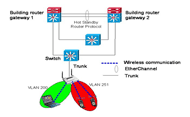Employees in shipping and receiving experience great flexibility with wireless IP phones.
This case study describes Cisco Systems® IT internal deployment of the Cisco & Wireless IP Phone 7920 in the shipping and receiving department at its second largest campus?Research Triangle Park (RTP) in North Carolina. Cisco IT deployed wireless IP phones for a team that is responsible for receiving, tracking, and delivering more than 250 packages a day for 2800+ employees dispersed over a 12-building campus.
"The 7920 saves us time," says Nick Williams, team lead for RTP's shipping and receiving team. "It allows us to call interoffice back to shipping and receiving to retrieve packages that need to be picked up here on campus that were not on the schedules we had previously downloaded into our PDAs. Also, we can quickly call back to shipping and receiving to help a customer track down a package without the need to ask the customer if we can use their phone or spend the time hunting down a phone in an empty conference room."
"We tried two-way radios but their range wasn't all that great," says Kevin Rooney, part of Work Place Resources (WPR) in the large RTP campus. "We tried two-way and analog pagers, but they weren't so reliable and as simple and quick as these phones. Customers frequently want to know where and when a package is delivered and they want to talk directly to the driver without pages and callbacks. We tried cellular phones but their coverage isn't that great inside these buildings, and we tried Nextel's cell plus two-way radio service but this was too expensive."
Normally, before drivers leave the dock, they download the schedule for deliveries and pickups to their Personal Digital Assistant (PDA), which they can update during the day at two hotspots on the RTP campus. However, PDAs by themselves are not enough to guide the drivers during the hectic day. Frequently there are urgent deliveries that are not on the drop-off schedule downloaded into the PDA-last minutes pickups or a package might already be dropped off prior to their scheduled pickup, or a package might have been given to another driver, leaving the scheduled driver searching and tracking a nonexistent package. Drivers had to borrow phones at employee desks or in conference rooms to call the shipping department for information, and when they were traveling without a phone they could not be reached at other times during the day.
Cisco needed increased reachability for this mobile team with a cost-effective solution that benefited from the existing (wireless) infrastructure on campus and acted as a smooth extension of their IP telephony environment. "So, when Marc Holloman from Cisco IT called me to ask if we wanted to try these wireless IP phones, we jumped right on that," says Rooney.
Nick Williams,
Team Lead,
Cisco Shipping and Receiving
The Cisco Wireless IP Phone 7920 is an easy-to-use IEEE 802.11b wireless IP phone that provides comprehensive voice communications in conjunction with Cisco CallManager and Cisco Aironet® series of Wi-Fi (IEEE 802.11b) access points. These phones can be configured with the exact same extension as the office phone and are as cost effective to use as any IP "land line" in the Cisco offices. The Cisco Wireless IP Phone 7920 is similar in overall phone functions to the Cisco IP Phone 7960G, and it provides enhanced wireless LAN (WLAN) security through enhanced Wired Equivalent Privacy; quality of service (QoS) functionality through 802.11e; and Layer 2 mobility for Cisco employees.
Cisco started to deploy the Cisco Wireless IP Phone 7920s shortly after they were introduced in 2003, first to select groups of users such as Sales and Shipping & Receiving (see Figure 1). This limited deployment gave IT the chance to help employees with unique needs, like in the shipping department; and it also helps Sales, helps Cisco IT to understand the product, and helps the product by allowing real-world users to provide feedback to the business units regarding their experience with these Cisco products.
Deploying a wireless IP phone service requires preliminary planning and provisioning work. The Cisco WLAN network in RTP consists of Cisco Aironet 350 Series access points, several per floor (about one access point for every 25 users) to give WLAN data access to PC users. Each building has a separate VLAN for added security and manageability. The Cisco Wireless IP 7920 Phone does not support specific security parameters designed for wireless clients on the data VLAN. By placing voice and data on separate VLANs tied to separate Service Set Identifiers, IT has the flexibility of customizing features such as security and QoS to accommodate the needs of each individual wireless device. This ensures that wireless PCs will associate to the data VLAN and that Cisco Wireless IP 7920 phones will associate to the voice VLAN. In addition, the Dynamic Host Configuration Protocol scopes were configured to pass a Trivial File Transfer Protocol server so that the users would not have to statically set it on their phones. This required Cisco IT to enable voice and data VLANs on the wireless access points and at the connecting switches within the network (see Figure 2).
Putting voice on a data network requires QoS on the underlying network. Access points bring both data and voice packets onto the network, and small data packets can get delayed behind larger data packets, which reduces voice quality on the call. Cisco IT prioritized voice packets by mapping them to smaller contention windows within the access point data streams and mapped these smaller windows for voice traffic into a special class of service on the RTP campus LAN.
Security is always an issue with wireless traffic. Wireless signals can be picked up by anyone who is close enough and has the right receiver, so the signal must be encrypted. Cisco IT used the Cisco version of Temporal Key Integrity Protocol (TKIP) with message integrity check (MIC), a strong encryption method that prevents eavesdropping. TKIP encrypts each voice packet with a different encryption key and a much stronger key than was used in previous encryption procedures. The MIC acts as a check to ascertain if the packet has been tampered with in any way. Together they provide a robust security solution for wireless voice. Newer Cisco Wireless IP 7920 phones support Wi-Fi Protected Access (WPA), a standards-based security solution from the Wi-Fi Alliance that includes TKIP/MIC, a subset of the 802.11i security standards for wireless. Cisco IT is investigating supporting WPA for future deployments of wireless voice.
After an overnight charge in the desktop charger, each phone is ready to go for another day of intense use in each Cisco building. With recent added access points above the docks, the phones work everywhere that the team needs to be reached or needs the opportunity to call the main office for specific information or customer services.
Without the need to pay for additional pager, cellular, radio, or walkie-talkie services, the direct cost savings for Cisco are obvious, not only because there is no monthly service fee but because there are fewer call or pager charges when using the onsite Cisco IP telephony voice network.
Having their extension on their "hip," drivers have no more need to later return pages or phone calls, wait for messages, or leave voice mail. The team communicates by dialing an extension regardless of where they are physically located at that moment. Their regular phone extension is available at any time during the day.
When there are last minute pickups, drivers are notified quickly before they leave the building, saving themselves a trip, or they can be notified that a package is already dropped off, eliminating searching and tracking a package that was supposed to be picked up. This saves a tremendous amount of time when there is a need to track a shipped package, because a quick call can clarify a misunderstanding, "especially in the evening time where the pickups from the customers are most crucial," says Williams. "And we no longer have to search for a phone when we need to quickly verify something, we can literarily keep moving."
"We can be in direct communication with our customers and this phone helps a great deal with customer services issues. When we sign for a FedEx package, a customer calls us directly wanting to know where their package is," says Williams. "And when we need to call back to the main office to help a customer track their package, customers like it that we don't need to borrow their phone."
"We would like to get our mail teams on board as well," explains Rooney. "Because our mail teams also deliver inter-office packages, and there are a lot of similar mail routes, we can use wireless IP phones in pretty much the same way and increase our efficiency by teaming and close communication." Cisco IT is also looking at possible services that could be accessed over the wireless IP phone that would allow shipping personnel to interface with their shipping application directly while in other buildings, and provide them with faster updates about changes to their schedule, or provide customers real time package tracking information.
Other people within Cisco, especially managers who spend a lot of time in meetings in buildings across the campus, are also looking at this and other early deployments of the Cisco Wireless IP 7920 Phone within Cisco.

